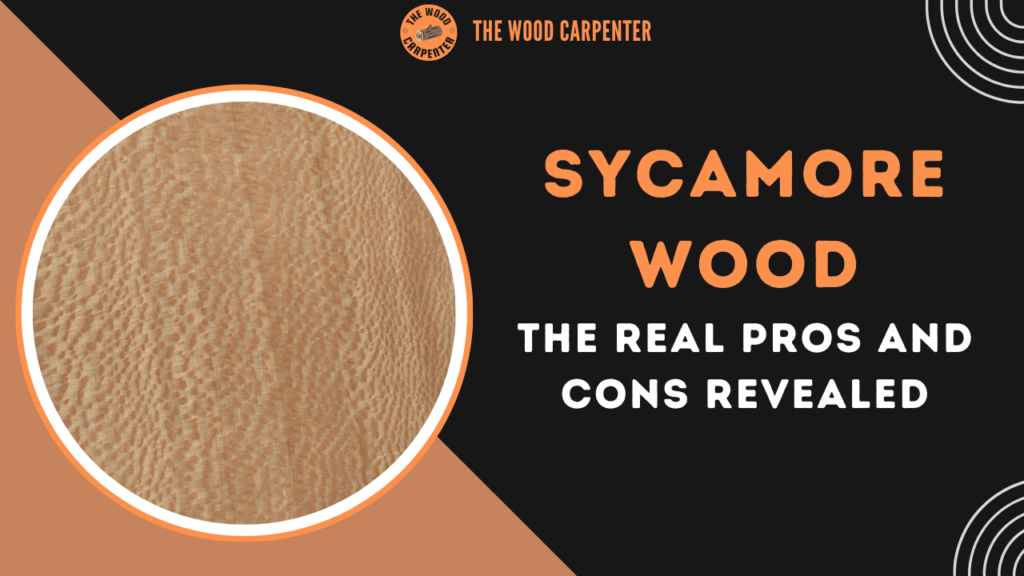
Sycamore wood comes mainly from the American sycamore tree (Platanus occidentalis) and its European relative (Acer pseudoplatanus). While it’s not as well-known as popular woods like oak or maple, sycamore has many great qualities.
It’s easy to work with, looks nice, and can be used in many ways. This guide will help you understand what sycamore wood is, what it’s used for, its pros and cons, and answer common questions about it.
What Is Sycamore Wood?
Sycamore is a type of hardwood (not softwood). It has a smooth, even texture and an interlocked grain, which gives it a unique look. The color is usually light, making it great for clean, bright finishes.
The American sycamore is one of the biggest hardwood trees in North America. People sometimes call it “buttonwood” because of its round fruit, or “ghost tree” because of its pale, white bark.
Sycamore wood is medium-heavy and strong. It has a Janka hardness of 770 lbf, which means it’s about as hard as southern yellow pine or Honduras mahogany—not super hard, but still durable enough for many uses.
Physical Properties of Sycamore Wood
Sycamore wood has a variety of physical properties that make it suitable for different applications:
Color: The heartwood can be pale yellow to light brown, while the sapwood is a creamy white.
Grain Pattern: The grain is fine and straight, which makes it rather easy to work with.
Hardness: Sycamore wood is moderately hard, but not as tough as oak or hickory. This makes it manageable for carving and shaping.
Density: It has a moderate density, which contributes to its weight and strength, without being overly heavy.
Workability
Sycamore wood is usually easy to work with, whether you’re using hand tools or machines.
But because it has a twisting grain pattern, it can sometimes tear or splinter when you cut or smooth it. To avoid this, use sharp and fast-moving tools.
It glues, stains, and finishes well, but staining can be a bit tricky because the grain is so tight.
It works great on a lathe, so you can make bowls or round shapes easily.
It’s good for carving, but not good for steam bending, as it doesn’t bend well when heated.
Durability and Care
Rot Resistance:
Sycamore wood does not resist rot or insects very well. It can break down easily, so it’s not good for outdoor use unless you treat and seal it properly.
Stability:
Sycamore can warp, twist, or crack while drying. It also reacts to changes in humidity and temperature. So it needs to be dried carefully and sealed well to stay in good shape.
Maintenance:
To keep sycamore wood looking good and lasting long:
- Clean it regularly
- Keep it dry
- Use protective finishes or sealants
This helps protect the wood and keeps it from getting damaged over time.
Common Uses
Sycamore’s versatility makes it suitable for a wide range of applications:
Furniture: Used for tables, chairs, cabinets, and accent pieces, especially when a unique grain pattern is desired.
Flooring: Offers an attractive, light-colored alternative to more common hardwoods, though it may wear faster in high-traffic areas.
Veneer and Paneling: The lacewood figure is highly prized for decorative veneers, paneling, and wainscoting.
Butcher Blocks and Cutting Boards: Its resistance to splitting and fine texture make it suitable for butcher blocks and kitchenware.
Musical Instruments: Used for guitar backs, sides, and other stringed instruments due to its acoustic properties.
Turned and Carved Items: Ideal for bowls, platters, spoons, and intricate carvings.
Also read:
Gidgee Wood: 7 Key Characteristics You Need to Know
Poplar Wood 101: Detailed Insights and Practical Uses for DIYers
Maple Wood: Everything You Need to Know
Advantages of Sycamore Wood
| Advantage | Description |
| Attractive Appearance | Light color and dramatic lacewood figure, especially when quartersawn. |
| Workability | Machines, turns, glues, and finishes well with sharp tools. |
| Versatility | Suitable for furniture, cabinetry, flooring, veneers, and more. |
| Sustainable | Not listed as threatened; often available as a byproduct of forest management. |
| Food-Safe | Does not taint food, making it excellent for kitchenware. |
Disadvantages of Sycamore Wood
| Disadvantage | Description |
| Poor Rot Resistance | Susceptible to decay and insect attack; not ideal for outdoor use. |
| Prone to Warping | Can twist, warp, or check during drying and with humidity changes. |
| Interlocked Grain Issues | Grain can create tearout and make machining and finishing harder. |
| Color Inconsistency | Variability in color and grain may not suit every project. |
| Moderate Hardness | Softer than many hardwoods, making it prone to dents and wear. |
Sustainability
Sycamore is not listed in the CITES appendices or on the IUCN Red List, so it is considered a sustainable and legal wood source for most projects. American sycamore grows rapidly and is abundant in its native range.
Frequently Asked Questions (FAQ)
1. Is sycamore a hardwood or softwood?
Sycamore is a true hardwood, valued for its strength and fine texture.
2. Is sycamore wood good for furniture?
Yes, sycamore is used for furniture due to its attractive appearance and workability, though it is best suited for indoor pieces.
3. Why isn’t sycamore used more often for lumber?
Its tendency to warp and twist during drying, along with lower outdoor durability and challenging grain, make it less popular than other hardwoods.
4. Is sycamore wood durable?
Sycamore is moderately durable for interior uses but is not rot-resistant and should not be used outdoors without treatment.
5. Does sycamore wood have any special visual features?
Yes, quartersawn sycamore displays a unique lacewood or flecked pattern, making it highly decorative.
6. How does sycamore compare to maple?
Sycamore has a similar fine texture and light color to maple but is generally softer and more prone to movement.
7. Can sycamore be used for kitchenware?
Yes, it is food-safe, does not taint food, and is often used for cutting boards, spoons, and bowls.
8. Is sycamore wood expensive?
Sycamore is usually moderately priced, but quartersawn boards with dramatic figure can be more costly.
9. Does sycamore wood have any odor or toxicity?
Sycamore doesn’t have a strong smell, and people who are allergic to wood dust don’t seem to have any problems with it.
10. What’s the best way to finish sycamore wood?
Use sharp tools to avoid tearout, and apply finishes carefully to highlight the grain. Staining can be challenging due to tight grain, so test finishes on scrap first.

